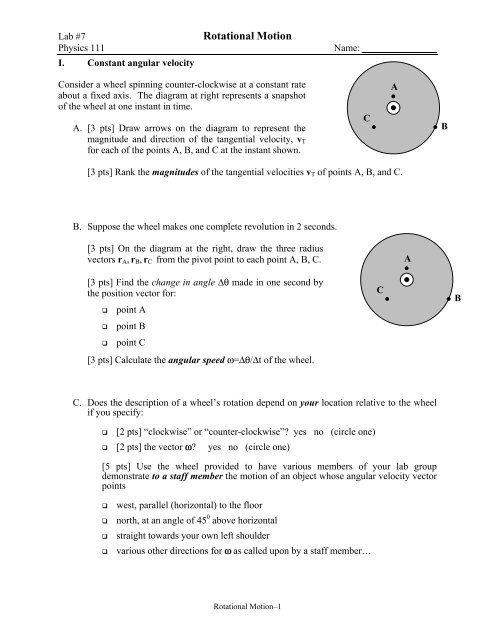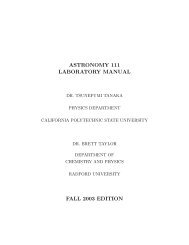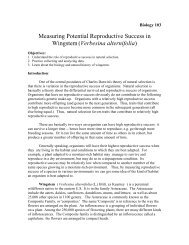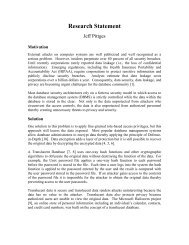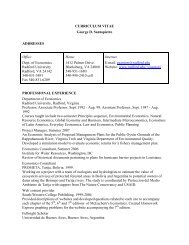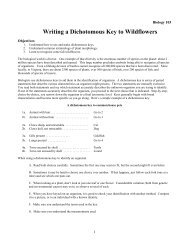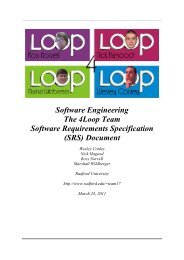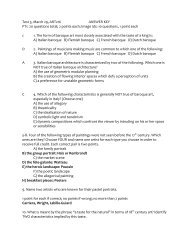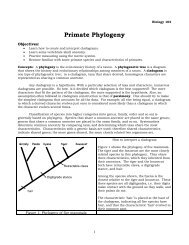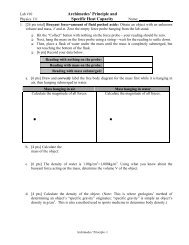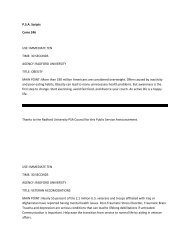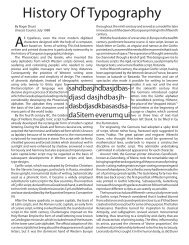lab 7; Mar 19 â rotational motion
lab 7; Mar 19 â rotational motion
lab 7; Mar 19 â rotational motion
You also want an ePaper? Increase the reach of your titles
YUMPU automatically turns print PDFs into web optimized ePapers that Google loves.
Lab #7<br />
Physics 111<br />
I. Constant angular velocity<br />
Rotational Motion<br />
Name:<br />
Consider a wheel spinning counter-clockwise at a constant rate<br />
about a fixed axis. The diagram at right represents a snapshot<br />
of the wheel at one instant in time.<br />
A. [3 pts] Draw arrows on the diagram to represent the<br />
magnitude and direction of the tangential velocity, v T<br />
for each of the points A, B, and C at the instant shown.<br />
C<br />
A<br />
B<br />
[3 pts] Rank the magnitudes of the tangential velocities v T of points A, B, and C.<br />
B. Suppose the wheel makes one complete revolution in 2 seconds.<br />
[3 pts] On the diagram at the right, draw the three radius<br />
vectors r A , r B , r C from the pivot point to each point A, B, C.<br />
A<br />
[3 pts] Find the change in angle Δθ made in one second by<br />
the position vector for:<br />
<br />
<br />
<br />
point A<br />
point B<br />
point C<br />
[3 pts] Calculate the angular speed ω=Δθ/Δt of the wheel.<br />
C<br />
B<br />
C. Does the description of a wheel’s rotation depend on your location relative to the wheel<br />
if you specify:<br />
<br />
[2 pts] “clockwise” or “counter-clockwise”? yes no (circle one)<br />
[2 pts] the vector ω? yes no (circle one)<br />
[5 pts] Use the wheel provided to have various members of your <strong>lab</strong> group<br />
demonstrate to a staff member the <strong>motion</strong> of an object whose angular velocity vector<br />
points<br />
<br />
<br />
<br />
<br />
west, parallel (horizontal) to the floor<br />
north, at an angle of 45 0 above horizontal<br />
straight towards your own left shoulder<br />
various other directions for ω as called upon by a staff member…<br />
Rotational Motion–1
Lab #7<br />
Rotational Motion<br />
Physics 111<br />
Name:<br />
II. Changing angular velocity: Be sure to use your wheels for each situation described below.<br />
A. Make the initial angular velocity of a wheel ω 0<br />
point due north, parallel to the <strong>lab</strong> floor. In<br />
each case described below, determine the magnitude and direction of the change in angular<br />
velocity, which is the vector Δω. Note the compass directions drawn to the right.<br />
North<br />
<br />
[3 pts] the wheel were made to<br />
spin faster, keeping the axis of<br />
rotation fixed. Draw this on the<br />
diagram at the right.<br />
ω 0<br />
<br />
[3 pts] the wheel were rotated by<br />
90° such that the final angular<br />
velocity is due east, but continued<br />
to spin at the same rate.<br />
ω 0<br />
B. For an object rotating about a fixed axis, describe the relative orientation of ω and α if the<br />
object is:<br />
<br />
<br />
[3 pts] spinning faster and faster<br />
[3 pts] spinning slower and slower<br />
C. Two geared wheels roll on each other without slipping. One<br />
has twice the radius of the other.<br />
A string is wrapped around the axis of the small wheel<br />
as shown in the diagram, and a 1.0-kg mass is<br />
attached to the string.<br />
radius = 2R<br />
Initially, the larger wheel is held in place such that the entire<br />
apparatus is stationary.<br />
i. The wheels are released so they are free to move.<br />
[3 pts] Is the 1.0-kg mass accelerating? yes no (circle one)<br />
radius = R<br />
[3 pts] Explain how the acceleration compares to that of a freely<br />
falling object (i.e., is the acceleration of the mass 9.8 m/s 2 ?).<br />
Rotational Motion–2
Lab #7<br />
Rotational Motion<br />
Physics 111<br />
ii. During the time that the mass is falling, find:<br />
Name:<br />
<br />
[4 pts] the direction of ω for the small wheel. Explain how you determined this<br />
direction.<br />
<br />
[4 pts] the direction of α for the small wheel. Explain how you determined this<br />
direction.<br />
iii. During the time that the mass is falling, compare:<br />
<br />
[4 pts] the angular velocities (both magnitude and direction) of the large and small<br />
wheels. If one has a larger angular velocity, give a specific number of times larger.<br />
<br />
[4 pts] the angular accelerations (both magnitude and direction) of the large and small<br />
wheels. If one has a larger angular acceleration, state how much larger. Explain.<br />
III.<br />
Applications: A bicycle wheel is mounted on a fixed, frictionless axle. A light string is<br />
wound around the wheel’s rim; a weight is attached to the string.<br />
At t = t o , the weight is released from rest; the weight has not started to move.<br />
At t = t 1 , the weight is falling, but the string is still partially wound around the wheel.<br />
At t = t 2 , the weight and string have both reached the ground; the wheel is still turning.<br />
A<br />
A<br />
weight just<br />
released from<br />
rest<br />
weight<br />
falling<br />
A<br />
weight and string<br />
on ground;<br />
wheel still turning<br />
t = t 0 t = t 1 t = t 2<br />
Rotational Motion–3
Lab #7<br />
Physics 111<br />
Rotational Motion<br />
Name:<br />
A. [4 pts] What is the direction of the angular velocity ω of the wheel at each of the three times<br />
shown? If ω=0 at any time, state that explicitly.<br />
B. [4 pts] What is the direction of the wheel’s angular acceleration α at each of the three times<br />
shown? If α=0 at any time, state that explicitly, and explain why you think α = 0.<br />
C. [4 pts] Rank the centripetal acceleration of point A at the three times shown (a c,0 , a c,1 , a c,2 )<br />
from largest to smallest. If any of these is zero, state that explicitly. Explain how you<br />
determined your ranking.<br />
D. Describe a real-life situation involving a turning disk such that each of the following cases is<br />
true. All of the cases below are possible.<br />
[3 pts] α = 0 and a c = 0<br />
[3 pts] α ≠ 0 and a c = 0<br />
[3 pts] α = 0 and a c ≠ 0<br />
[3 pts] α ≠ 0 and a c ≠ 0<br />
Rotational Motion–4


